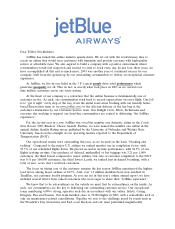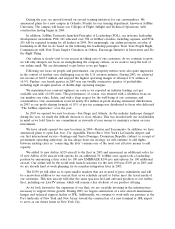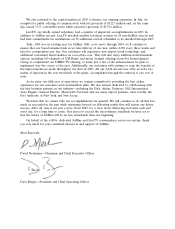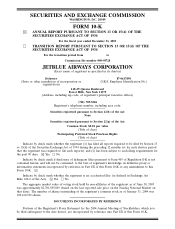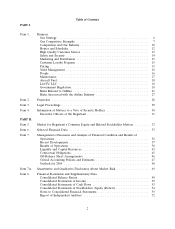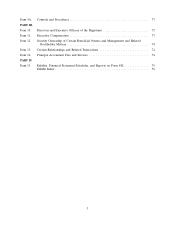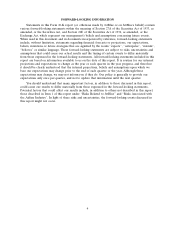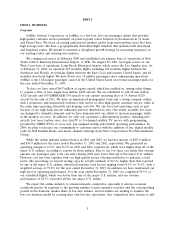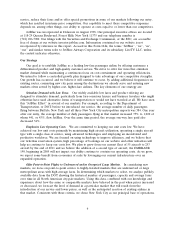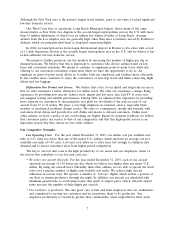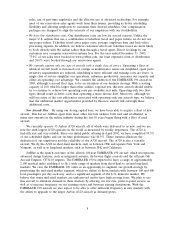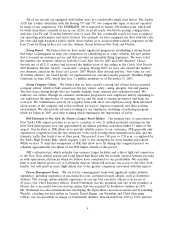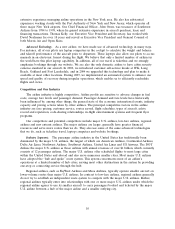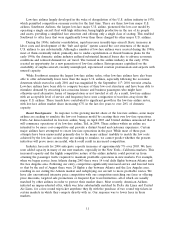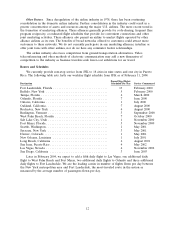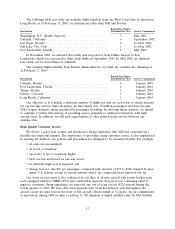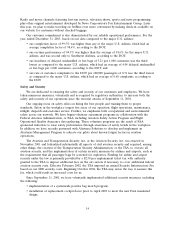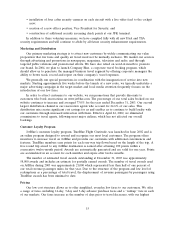JetBlue Airlines 2003 Annual Report Download - page 8
Download and view the complete annual report
Please find page 8 of the 2003 JetBlue Airlines annual report below. You can navigate through the pages in the report by either clicking on the pages listed below, or by using the keyword search tool below to find specific information within the annual report.PART I
ITEM 1. BUSINESS
Overview
JetBlue Airways Corporation, or JetBlue, is a low-fare, low-cost passenger airline that provides
high-quality customer service primarily on point-to-point routes between 22 destinations in 11 states
and Puerto Rico. We focus on serving underserved markets and/or large metropolitan areas that have
high average fares. We have a geographically diversified flight schedule that includes both short-haul
and long-haul routes. We intend to maintain a disciplined growth strategy by increasing frequency on
our existing routes and entering new markets.
We commenced service in February 2000 and established our primary base of operations at New
York’s John F. Kennedy International Airport, or JFK. On August 28, 2001, we began service at our
West Coast base of operations, Long Beach Municipal Airport, which serves the Los Angeles area. As
of February 11, 2004, we operated 222 weekday flights, including 108 weekday flights between the
Northeast and Florida, 66 weekday flights between the East Coast and western United States, and 48
weekday short-haul flights. We have flown over 19 million passengers since commencing operations.
JetBlue is the 11th largest passenger carrier in the United States based on revenue passenger miles for
the year ended December 31, 2003.
To date, we have raised $467 million of equity capital, which has enabled us, among other things,
to acquire a fleet of new, single-class Airbus A320 aircraft. We are scheduled to add 98 new Airbus
A320 aircraft and 100 EMBRAER 190 aircraft to our current operating fleet of 55 Airbus A320
aircraft by the end of 2011. We have an experienced management team and a strong company culture
with a productive and incentivized workforce that strives to offer high-quality customer service, while at
the same time operating efficiently and keeping costs low. We also have low operating costs, in part
because of our high daily aircraft utilization and low distribution costs. Our widely available low fares
are designed to stimulate demand, and we have demonstrated our ability to increase passenger traffic
in the markets we serve. In addition, we offer our customers a differentiated product, including new
aircraft, low fares, leather seats, free LiveTV (a 24-channel satellite TV service with programming
provided by DIRECTV) at every seat, pre-assigned seating and reliable operating performance. In
2004, we plan to increase our commitment to customer service with the addition of free digital satellite
radio by XM Satellite Radio and movie channel offerings from News Corporation’s Fox Entertainment
Group.
While the airline industry suffered losses in 2003 and 2002, we had net income of $103.9 million
and $54.9 million for the years ended December 31, 2003 and 2002, respectively. We generated an
operating margin of 16.9% and 16.5% in 2003 and 2002, respectively, which were higher than all of the
major U.S. airlines, according to reports by those airlines. Due to our low fares, our yields (the average
amount one passenger pays to fly one mile) during 2003 were lower than all of the major U.S. airlines.
However, our low fares together with our high quality service offering enabled us to generate a load
factor (the percentage of aircraft seating capacity actually utilized) of 84.5%, higher than that reported
by any of the major U.S. airlines, which had domestic load factors ranging from 65.1% to 76.4%, with a
weighted average of 72.8% for the year ended December 31, 2003. In addition, we have maintained our
high level of operating performance. For the year ended December 31, 2003, we completed 99.5% of
our scheduled flights, which was better than any of the major U.S. airlines, and our on-time
performance of 84.3% exceeded all but one major U.S. airline.
We expect the airline industry to remain intensely competitive, especially if adverse economic
conditions persist. In response to the growing number of price-sensitive travelers and the corresponding
growth in the domestic market share of low-fare airlines, several airlines are seeking to emulate the
low-cost business model by creating their own low-fare operations. Our competitors have chosen to add
5

